lock SSANGYONG KORANDO 2013 Manual Online
[x] Cancel search | Manufacturer: SSANGYONG, Model Year: 2013, Model line: KORANDO, Model: SSANGYONG KORANDO 2013Pages: 1336, PDF Size: 92.18 MB
Page 763 of 1336

8712-03
(3) Passive LOCK
The passive LOCK (door LOCK) is activated by the door handle switch with a valid smart key present
within the passive entry actuation area.
Passive LOCK and verification by door handle switch
The ignition is turned OFF or ACC is turned ON.
All doors are closed and the driver door is unlocked.
The door handle switch on the driver or passenger door is pressed briefly.
The SKM verifies if a smart key is outside the vehicle using the door handle antenna (LF verification)
(The SKM searches the last smart key used first. Searching for a smart key signal from the outside
the vehicle is followed by searching from the inside the vehicle).
The verification signal (RF verification) from the smart key is sent to the REKES antenna of the SKM.
The SKM sends the Passive LOCK signal to the BCM through the B-CAN if the verified smart key is
found outside the vehicle.
The BCM receives the signal from the SKM and controls the door LOCK actuator and turn signal
lamp. (The buzzer sounds once and hazard warning lamp flashes twice when the system enters the
theft deterrent mode) -
1.
2.
3.
4.
5.
6.
If no smart key is identified as being outside the vehicle, the passive LOCK process is stopped and
restarted when the next signal is received from the door handle switch.
When the door handle switch is pressed with ACC ON and driver door unlocked, the SKM changes
the ignition status to OFF and sends the passive LOCK signal to the BCM through the B-CAN to lock
the door. The BCM ignores the signal if the ignition is turned ON. -
-
Page 764 of 1336

(4) Passive UNLOCK
The passive UNLOCK (door UNLOCK) is activated by the door handle switch with a valid smart key
present within the passive entry actuation area.
Passive UNLOCK and verification by door handle switch
The driver door is locked and the system in the theft deterrent mode.
The door handle switch on the driver or passenger door is pressed briefly.
The SKM verifies if a smart key is outside the vehicle using the door handle antenna (LF verification)
(The SKM searches the last smart key used first).
The verification signal (RF verification) from the smart key is sent to the REKES antenna of the SKM.
The SKM sends the Passive UNLOCK signal to the BCM through the B-CAN if the verified smart key
is found outside the vehicle.
The BCM receives the signal from the SKM and controls the door UNLOCK actuator and turn signal
lamp. (The buzzer sounds twice and hazard warning lamp flashes once when the theft deterrent
mode is deactivated) 1.
2.
3.
4.
5.
6.
If no smart key is identified as being outside the vehicle, the passive UNLOCK process is stopped
and restarted when the next signal is received from the door handle switch.
When the driver door is locked with ACC ON, the SKM sends the Passive UNLOCK signal to the
BCM through the B-CAN to unlock the door without changing the ignition status to OFF. (The vehicle
power is turned OFF when the door is opened.)
Smart key searching
* Theft deterrent mode: deactivated after searching the outside vehicle
* Theft deterrent mode deactivated: outside searching after inside searching -
-
-
Page 765 of 1336

8712-03
(5) Passive tailgate open
The tailgate open control is activated by the tailgate open switch with a valid smart key present within the
passive entry actuation area.
Passive tailgate open by tailgate open switch
When the tailgate is closed with all doors closed, the system enters the theft deterrent mode after
checking a valid smart key inside the vehicle. When a valid smart key is found inside the vehicle, the
external buzzer and smart key detected warning indicator is operated for 10 seconds.
If no smart key is identified as being outside the vehicle, the passive gate open process is stopped
and restarted when the next signal is received from the tailgate open switch.
Smart key searching
* Theft deterrent mode: deactivated after searching the outside vehicle
* Theft deterrent mode deactivated: outside searching after inside searching -
-
-The driver door is locked and the system in the theft deterrent mode.
The tailgate open switch signal is received.
The BCM sends the valid smart key verification request signal to the SKM.
The SKM verifies if a smart key is outside the vehicle using the corresponding rear bumper antenna
(LF verification) (The SKM searches the last smart key used first. If a valid smart key searching is
completed, searching for a key in the luggage compartment and inside the vehicle is started).
The verification signal (RF verification) from the smart key is sent to the REKES antenna of the SKM.
The SKM sends the Passive tailgate open signal to the BCM through the B-CAN if the verified smart
key is found outside the vehicle.
The BCM activates the tailgate open relay according to the signal received from the SKM.
(Only the theft deterrent mode for tailgate is deactivated.) -
1.
2.
3.
4.
5.
6.
Page 766 of 1336
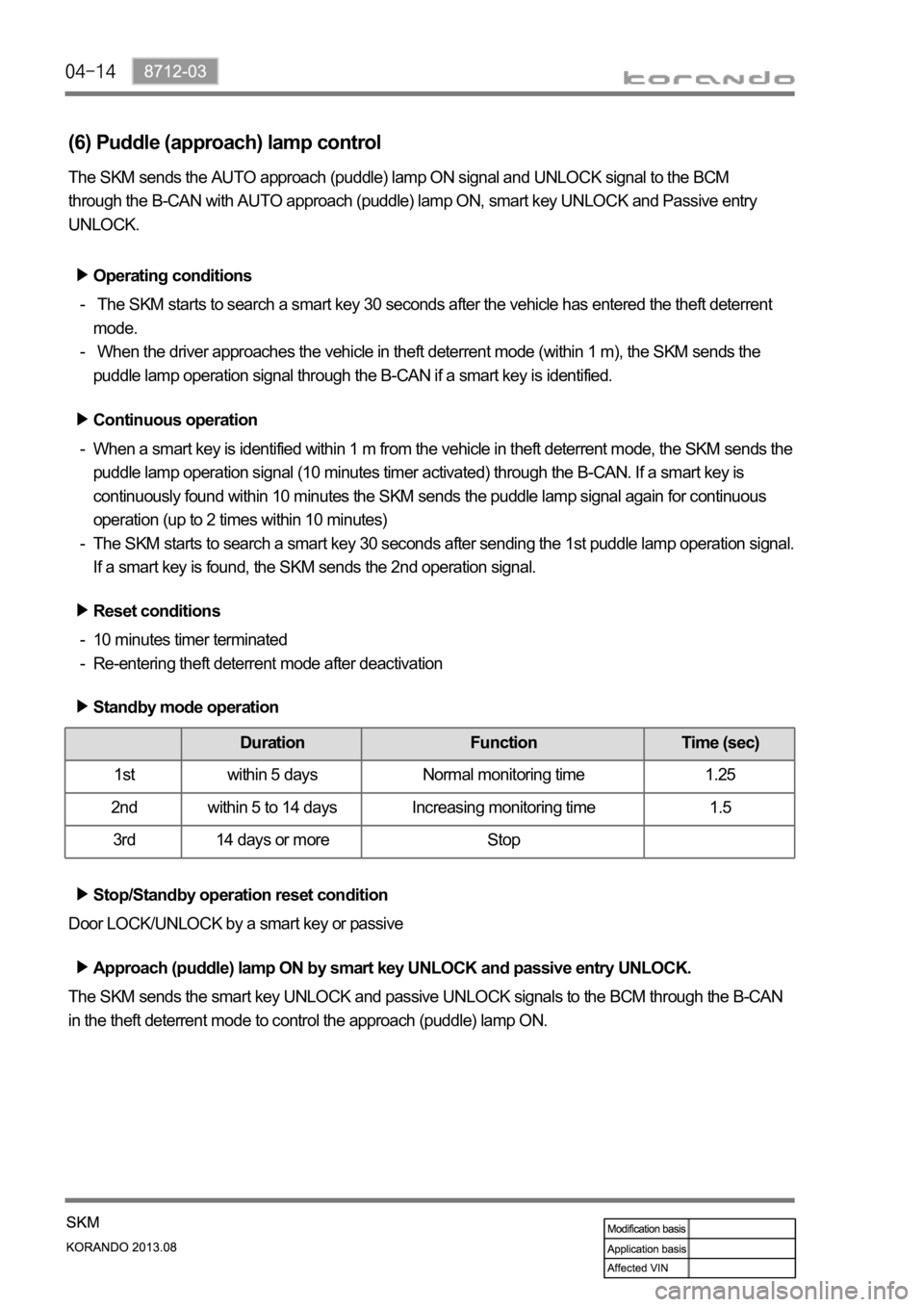
(6) Puddle (approach) lamp control
Operating conditions
The SKM starts to search a smart key 30 seconds after the vehicle has entered the theft deterrent
mode.
When the driver approaches the vehicle in theft deterrent mode (within 1 m), the SKM sends the
puddle lamp operation signal through the B-CAN if a smart key is identified. -
-
Continuous operation
Reset conditions
Standby mode operation
When a smart key is identified within 1 m from the vehicle in theft deterrent mode, the SKM sends the
puddle lamp operation signal (10 minutes timer activated) through the B-CAN. If a smart key is
continuously found within 10 minutes the SKM sends the puddle lamp signal again for continuous
operation (up to 2 times within 10 minutes)
The SKM starts to search a smart key 30 seconds after sending the 1st puddle lamp operation signal.
If a smart key is found, the SKM sends the 2nd operation signal. -
-
10 minutes timer terminated
Re-entering theft deterrent mode after deactivation -
-
Duration Function Time (sec)
1st within 5 days Normal monitoring time 1.25
2nd within 5 to 14 days Increasing monitoring time 1.5
3rd 14 days or more Stop
The SKM sends the AUTO approach (puddle) lamp ON signal and UNLOCK signal to the BCM
through the B-CAN with AUTO approach (puddle) lamp ON, smart key UNLOCK and Passive entry
UNLOCK.
Door LOCK/UNLOCK by a smart key or passiveStop/Standby operation reset condition
The SKM sends the smart key UNLOCK and passive UNLOCK signals to the BCM through the B-CAN
in the theft deterrent mode to control the approach (puddle) lamp ON. Approach (puddle) lamp ON by smart key UNLOCK and passive entry UNLOCK.
Page 767 of 1336

8712-03
5. REKES CONTROL FUNCTION
REKES LOCK operation
The REKES LOCK signal is sent when the LOCK button on the smart key is pressed briefly (0.1 sec.
to 1.5 sec.).
The SKM receives the REKES LOCK signal and sends the REKES LOCK request signal to the
BCM through B-CAN.
The BCM outputs the door LOCK signal according to the signal received from the SKM. 1.
2.
3.
When the REKES LOCK signal is received with the ACC ON, the ACC is turned OFF and the
REKES LOCK signal is sent.
REKES UNLOCK operation
The REKES UNLOCK signal is sent when the UNLOCK button on the smart key is pressed briefly
(0.1 sec. or more).
The SKM receives the REKES UNLOCK signal and sends the REKES UNLOCK request signal to
the BCM through B-CAN.
The BCM outputs the door UNLOCK signal according to the signal received from the SKM. 1.
2.
3.
Tailgate open operation
The ignition is turned OFF, ON, or ACC is turned ON.
The tailgate open signal is sent when the tailgate open button on the smart key is pressed 1 second
or more.
The SKM receives the tailgate open signal and sends the tailgate open request signal to the BCM
through B-CAN.
The BCM activates the tailgate open relay when the tailgate open switch is pressed. 1.
2.
3.
4.
Page 769 of 1336

8712-03
6. SMART KEY FUNCTION LIMITATION (SILENT)
Silent smart key
Limits the passive UNLOCK function when searching for the smart key which activated the REKES
LOCK inside the vehicle (including external/internal antenna overlapping area), to prevent the break-in.
Silent smart key activation -
The REKES LOCK (theft deterrent mode activation) request signal is sent by a smart key inside the
vehicle.
The smart key activated REKES LOCK is found in the vehicle.
All smart keys in the vehicle including the one that output the REKES LOCK are memorized as
silent smart keys, and the passive UNLOCK is not available with these keys. 1.
2.
3.
Silent smart key function -
Passive UNLOCK not available
Passive start & power control available
REKES function available 1.
2.
3.
Cancellation of silent smart key -
When the theft deterrent mode is deactivated, the silent smart key functions are available. 1.
Silent activation conditions
- All doors closed (B-CAN)
- Theft deterrent mode activated (B-CAN)
- Smart key searchSilent: The passive UNLOCK is unavailable when
REKES LOCK is carried out with a smart key
inside the vehicle.
/DEACTIVATION
Page 770 of 1336
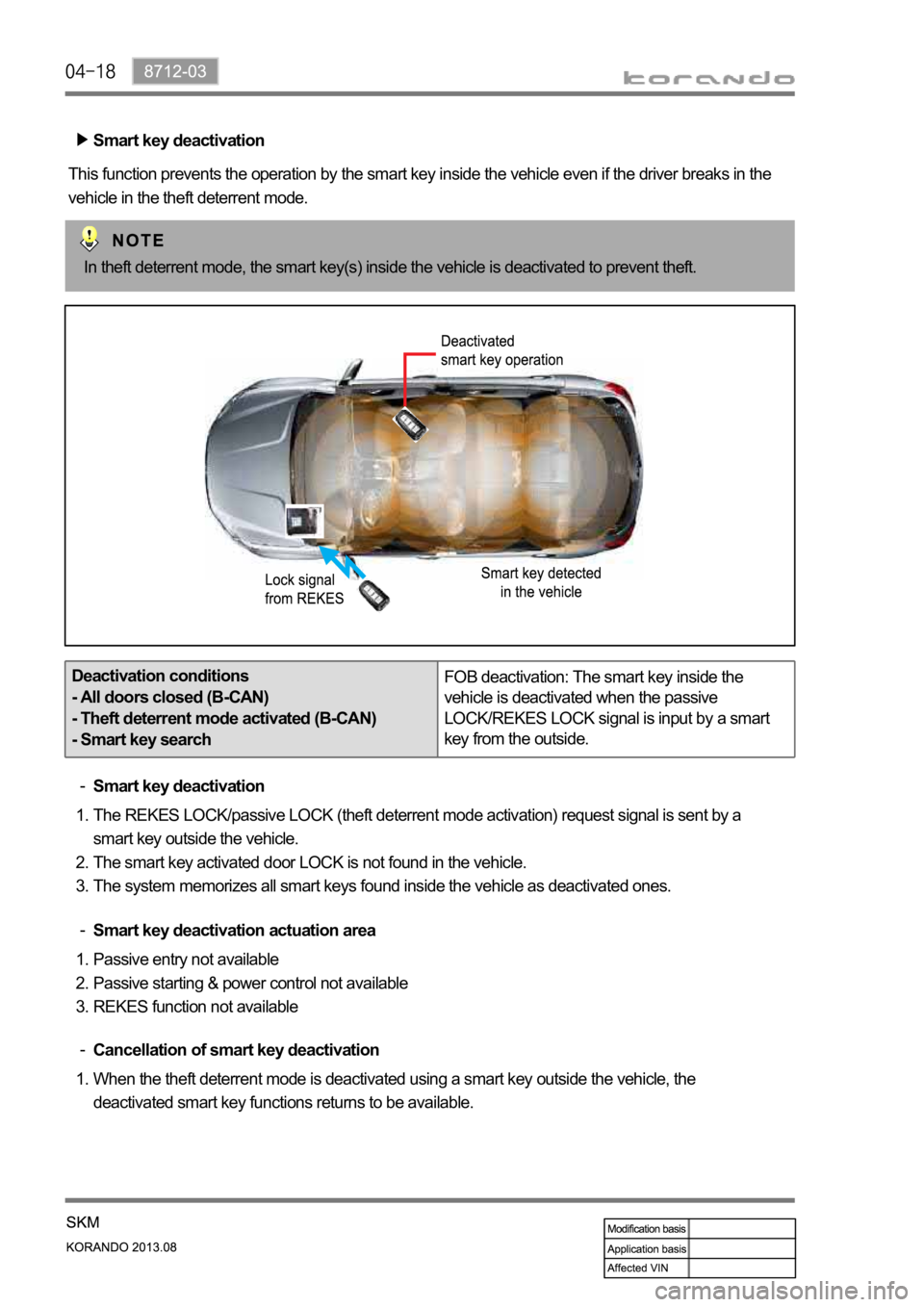
Smart key deactivation
This function prevents the operation by the smart key inside the vehicle even if the driver breaks in the
vehicle in the theft deterrent mode.
Deactivation conditions
- All doors closed (B-CAN)
- Theft deterrent mode activated (B-CAN)
- Smart key searchFOB deactivation: The smart key inside the
vehicle is deactivated when the passive
LOCK/REKES LOCK signal is input by a smart
key from the outside.
Smart key deactivation -
The REKES LOCK/passive LOCK (theft deterrent mode activation) request signal is sent by a
smart key outside the vehicle.
The smart key activated door LOCK is not found in the vehicle.
The system memorizes all smart keys found inside the vehicle as deactivated ones. 1.
2.
3.
Smart key deactivation actuation area -
Passive entry not available
Passive starting & power control not available
REKES function not available 1.
2.
3.
Cancellation of smart key deactivation -
When the theft deterrent mode is deactivated using a smart key outside the vehicle, the
deactivated smart key functions returns to be available. 1.In theft deterrent mode, the smart key(s) inside the vehicle is deactivated to prevent theft.
Page 772 of 1336
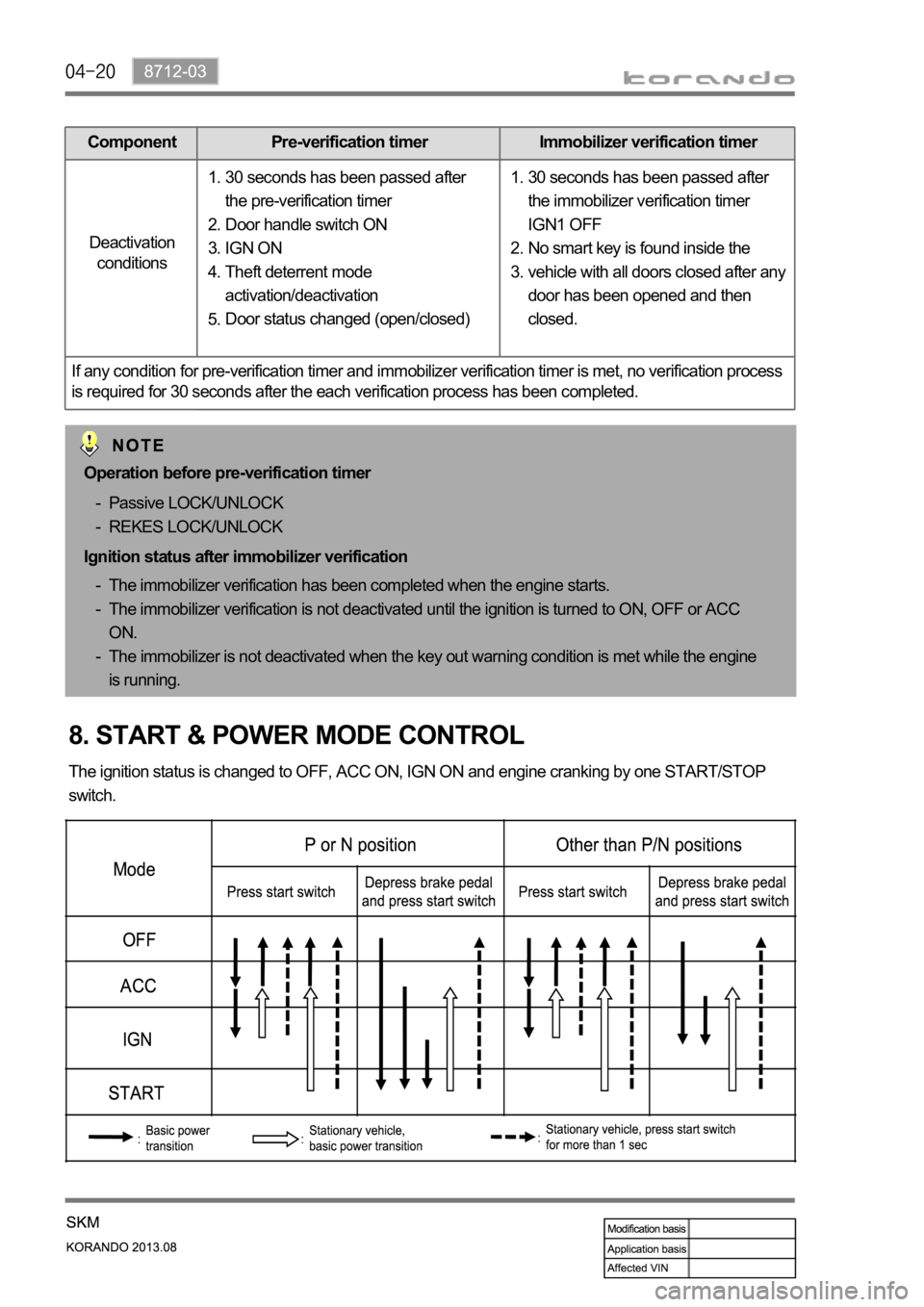
Component Pre-verification timer Immobilizer verification timer
Deactivation
conditions
If any condition for pre-verification timer and immobilizer verification timer is met, no verification process
is required for 30 seconds after the each verification process has been completed.
Operation before pre-verification timer
Passive LOCK/UNLOCK
REKES LOCK/UNLOCK -
-
Ignition status after immobilizer verification
The immobilizer verification has been completed when the engine starts.
The immobilizer verification is not deactivated until the ignition is turned to ON, OFF or ACC
ON.
The immobilizer is not deactivated when the key out warning condition is met while the engine
is running. -
-
-
8. START & POWER MODE CONTROL
The ignition status is changed to OFF, ACC ON, IGN ON and engine cranking by one START/STOP
switch.30 seconds has been passed after
the immobilizer verification timer
IGN1 OFF
No smart key is found inside the
vehicle with all doors closed after any
door has been opened and then
closed. 1.
2.
3. 30 seconds has been passed after
the pre-verification timer
Door handle switch ON
IGN ON
Theft deterrent mode
activation/deactivation
Door status changed (open/closed) 1.
2.
3.
4.
5.
Page 775 of 1336
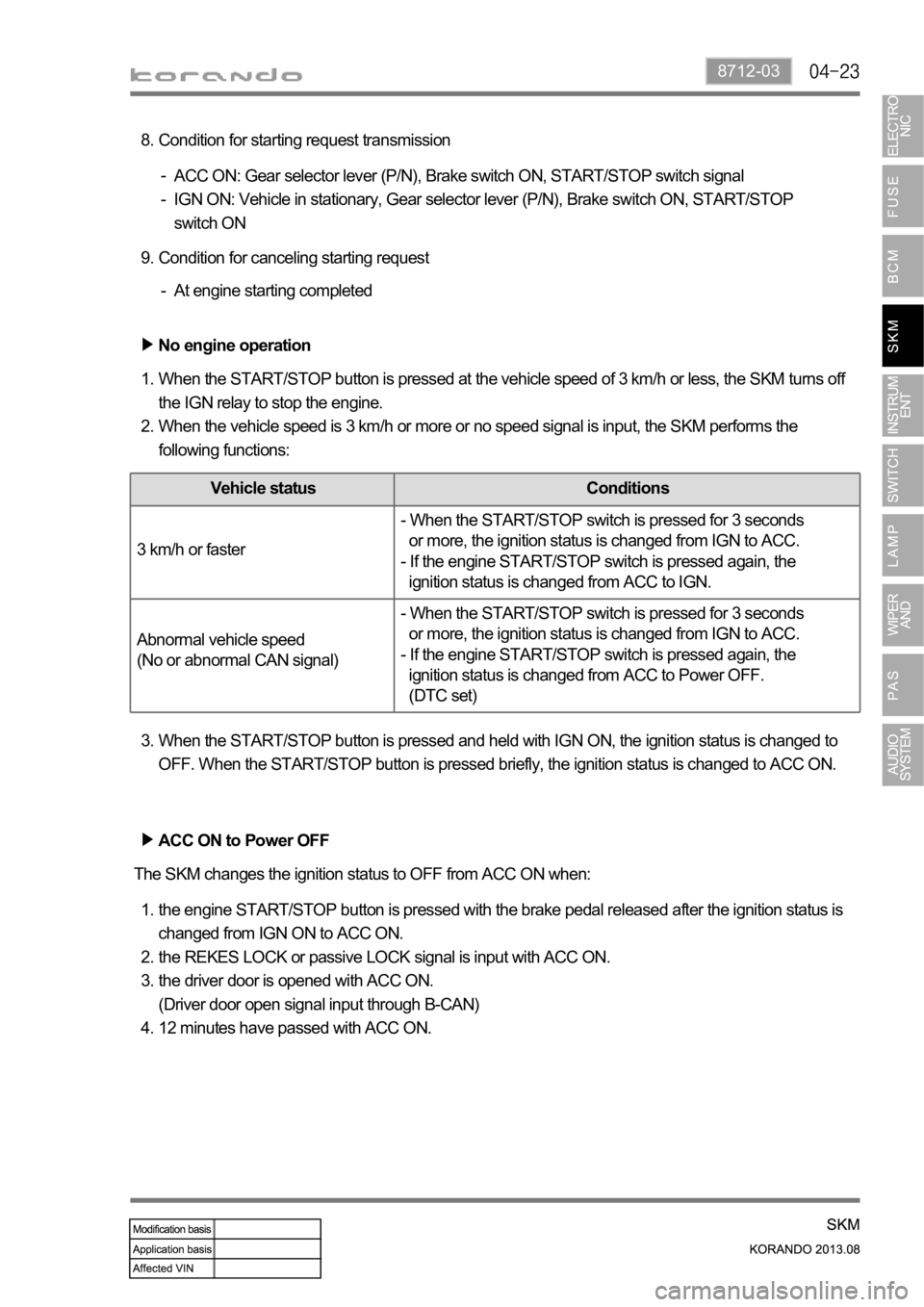
8712-03
No engine operation
When the START/STOP button is pressed at the vehicle speed of 3 km/h or less, the SKM turns off
the IGN relay to stop the engine.
When the vehicle speed is 3 km/h or more or no speed signal is input, the SKM performs the
following functions: 1.
2.
Vehicle status Conditions
3 km/h or faster - When the START/STOP switch is pressed for 3 seconds
or more, the ignition status is changed from IGN to ACC.
- If the engine START/STOP switch is pressed again, the
ignition status is changed from ACC to IGN.
Abnormal vehicle speed
(No or abnormal CAN signal)- When the START/STOP switch is pressed for 3 seconds
or more, the ignition status is changed from IGN to ACC.
- If the engine START/STOP switch is pressed again, the
ignition status is changed from ACC to Power OFF.
(DTC set)
When the START/STOP button is pressed and held with IGN ON, the ignition status is changed to
OFF. When the START/STOP button is pressed briefly, the ignition status is changed to ACC ON. 3.
ACC ON to Power OFF
The SKM changes the ignition status to OFF from ACC ON when:
the engine START/STOP button is pressed with the brake pedal released after the ignition status is
changed from IGN ON to ACC ON.
the REKES LOCK or passive LOCK signal is input with ACC ON.
the driver door is opened with ACC ON.
(Driver door open signal input through B-CAN)
12 minutes have passed with ACC ON. 1.
2.
3.
4.Condition for starting request transmission 8.
ACC ON: Gear selector lever (P/N), Brake switch ON, START/STOP switch signal
IGN ON: Vehicle in stationary, Gear selector lever (P/N), Brake switch ON, START/STOP
switch ON -
-
Condition for canceling starting request 9.
At engine starting completed -
Page 776 of 1336
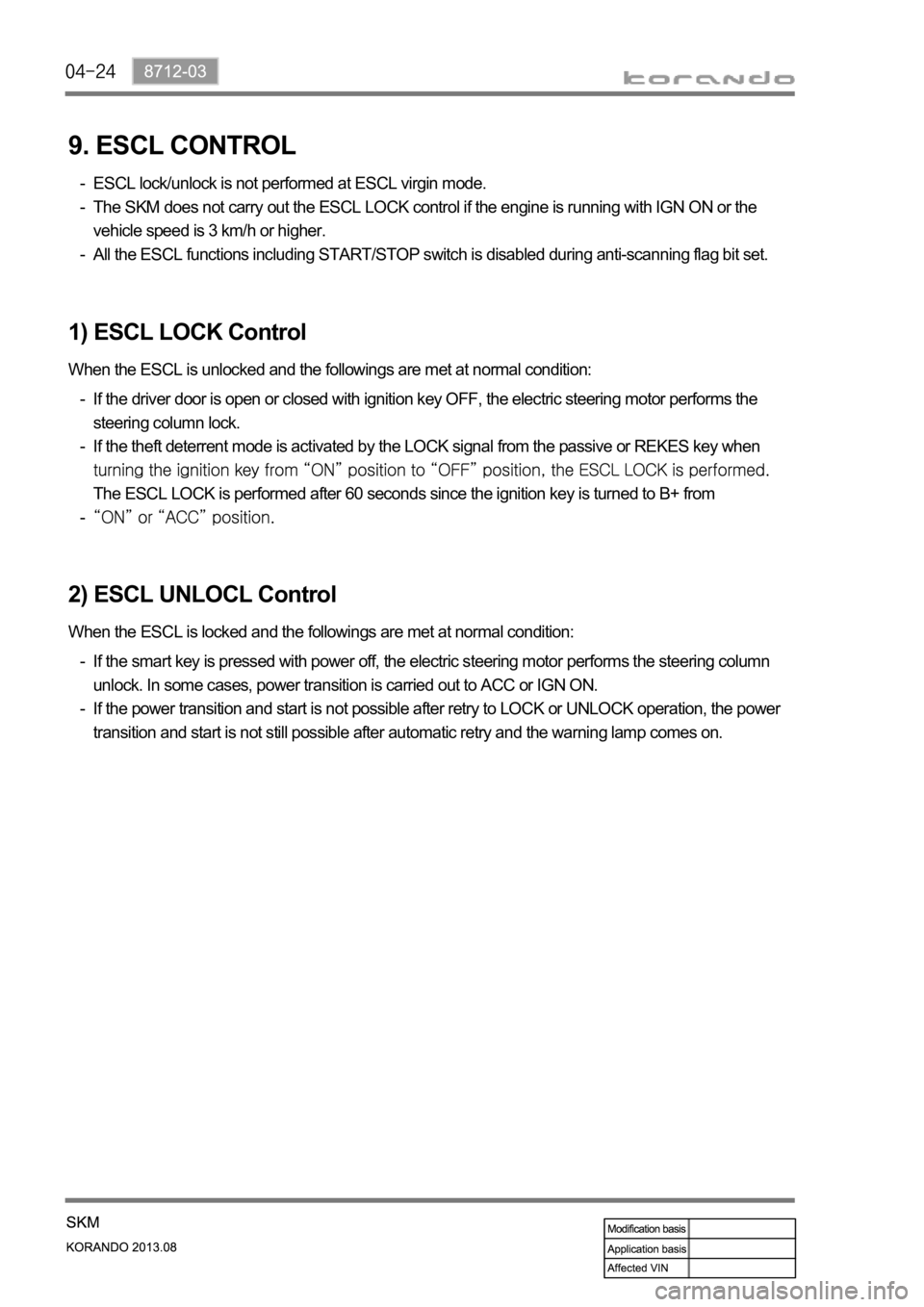
9. ESCL CONTROL
ESCL lock/unlock is not performed at ESCL virgin mode.
The SKM does not carry out the ESCL LOCK control if the engine is running with IGN ON or the
vehicle speed is 3 km/h or higher.
All the ESCL functions including START/STOP switch is disabled during anti-scanning flag bit set. -
-
-
If the smart key is pressed with power off, the electric steering motor performs the steering column
unlock. In some cases, power transition is carried out to ACC or IGN ON.
If the power transition and start is not possible after retry to LOCK or UNLOCK operation, the power
transition and start is not still possible after automatic retry and the warning lamp comes on. -
-
1) ESCL LOCK Control
When the ESCL is unlocked and the followings are met at normal condition:
If the driver door is open or closed with ignition key OFF, the electric steering motor performs the
steering column lock.
If the theft deterrent mode is activated by the LOCK signal from the passive or REKES key when
The ESCL LOCK is performed after 60 seconds since the ignition key is turned to B+ from
-
-
-
2) ESCL UNLOCL Control
When the ESCL is locked and the followings are met at normal condition: